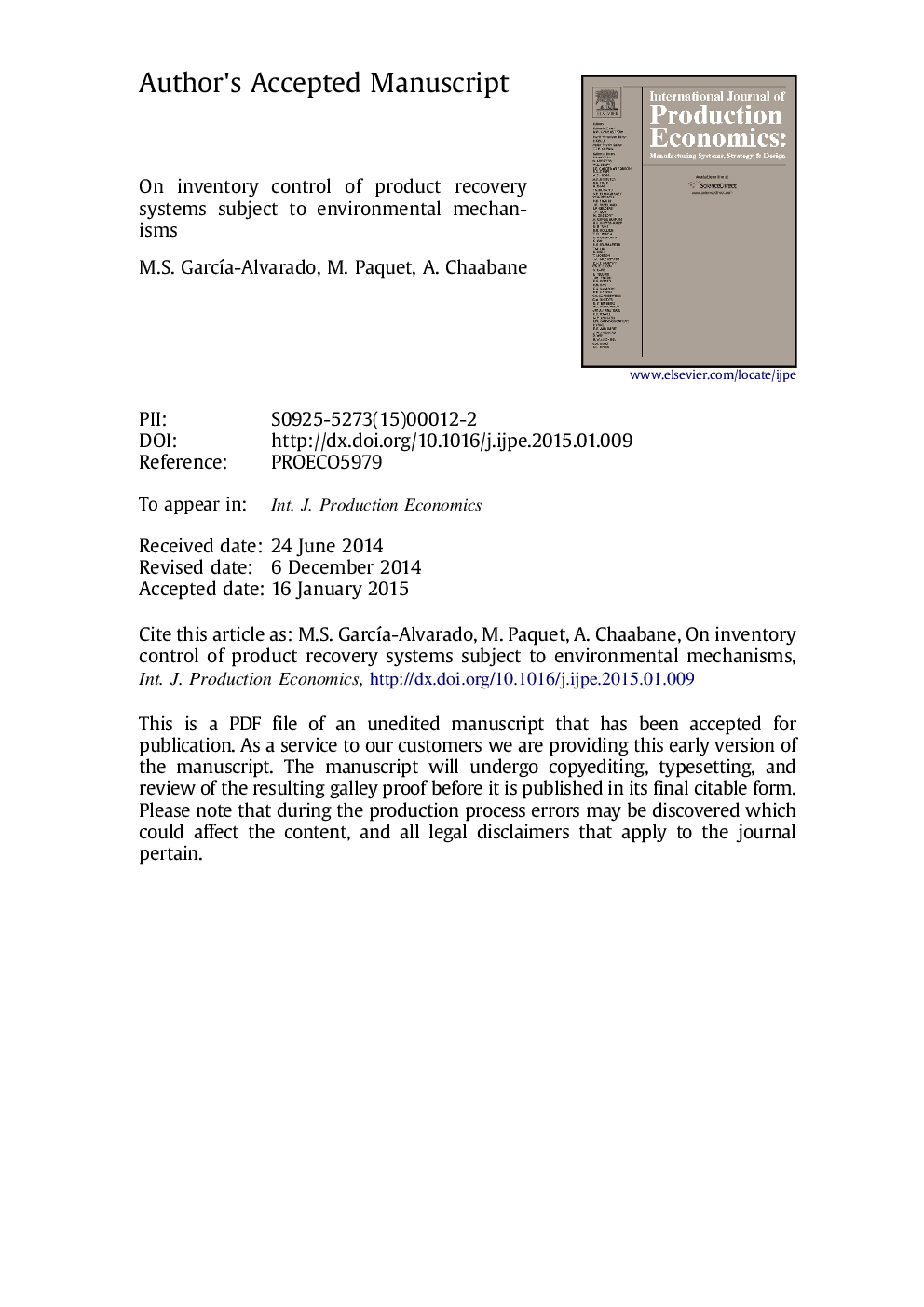| کد مقاله | کد نشریه | سال انتشار | مقاله انگلیسی | نسخه تمام متن |
|---|---|---|---|---|
| 5079745 | 1477547 | 2015 | 21 صفحه PDF | دانلود رایگان |
عنوان انگلیسی مقاله ISI
On inventory control of product recovery systems subject to environmental mechanisms
ترجمه فارسی عنوان
در کنترل موجودی از سیستم های بازیابی محصول با توجه به مکانیزم های محیطی
دانلود مقاله + سفارش ترجمه
دانلود مقاله ISI انگلیسی
رایگان برای ایرانیان
کلمات کلیدی
کنترل انبار، سیستم های بسته و تجارت، سیستم حلقه بسته الگوریتم ژنتیک،
ترجمه چکیده
هدف از این مقاله بررسی تاثیر کنترل موجودی در کاهش اثرات کربن یک سازمان است. با استفاده از یک مدل موجودی تصادفی، تحقیق ما با استفاده از قوانین زیست محیطی هزینه سنتی کاهش هزینه را گسترش می دهد. ما سیستم یکپارچه ای افقی محدود را در نظر می گیریم که به موجب آن تصمیمات مربوط به یک طرح توجیه انتشار گازهای گلخانه ای و تقاضای و بازده تصادفی است. تقاضا را می توان توسط دو منبع راضی کرد. منبع اولیه محیط زیست دوستانه اما گران است، در حالی که دوم مقرون به صرفه اما پیامدهای محیطی منفی است. این مشکل به عنوان یک مشکل پویا تصادفی، که در آن هر زمان مجددا تصویب و تصمیم گیری در مورد مدیریت کربن صورت می گیرد، فرموله می شود. هدف این است که چگونه تجدیدنظر و راهبردهای مدیریت کربن تحت تأثیر محدودیت های محیطی قرار گیرد. به طور خاص، با توجه به محدودیت محاسبات برنامه نویسی دینامیکی، به منظور گسترش یافته ها، ما یک الگوریتم ژنتیک برای یافتن راه حل های نزدیک بهینه برای نمونه های بزرگ پیشنهاد می کنیم. تجزیه و تحلیل حساسیت برای شناسایی تاثیر قیمت های تخفیف کربن، میزان انتشار و دیگر عوامل محیطی در روند تصمیم گیری انجام شده است. نتایج نشان می دهد که استراتژی های محیط زیستی و عوامل آنها بر تصمیم گیری های مجدد تاثیر می گذارد. یک تعهد نامه ای است که شرکت باید به تصمیمات استراتژیک توجه کند تا تصمیمات تاکتیکی و عملیاتی. علاوه بر این، اگر قیمت حق بیمه کربن به گونه ای باشد که منافع زیست محیطی هزینه های تکنولوژی کمتر آلاینده را جذب کند، باید تغییر سیاست موجودی انجام شود.
موضوعات مرتبط
مهندسی و علوم پایه
سایر رشته های مهندسی
مهندسی صنعتی و تولید
چکیده انگلیسی
The aim of this paper is to study the impact of inventory control in reducing the carbon footprint of an organization. Through a stochastic inventory model, our research extends the traditional minimization cost problem by incorporating environmental legislation. We consider a finite-horizon closed-loop system whereby decisions are subject to an emissions trading scheme and to random demand and returns. Demand can be satisfied by two sources. The primary source is environmentally friendly but expensive, whereas the second is cost effective but with negative environmental consequences. The problem is formulated as a stochastic dynamic problem, where replenishment and carbon management decisions must be made at each period. The objective is to describe how replenishment and carbon management strategies are affected by environmental constraints. In particular, considering the computation restriction of dynamic programming, in order to extend the results, we propose a genetic algorithm to find near-optimal solutions for larger instances. A sensitivity analysis is performed to identify the impact of carbon allowance prices, emission-cap and other environmental factors in the decision-making process. The results indicate that environmental strategies and their factors have an impact on replenishment decisions. There is an emission-cap from which a company must focus on strategic decisions rather than on tactical and operational decisions. In addition, if the carbon allowance price is such that the environmental benefit absorbs the cost of less polluting technology, a change in the inventory policy must be made.
ناشر
Database: Elsevier - ScienceDirect (ساینس دایرکت)
Journal: International Journal of Production Economics - Volume 165, July 2015, Pages 132-144
Journal: International Journal of Production Economics - Volume 165, July 2015, Pages 132-144
نویسندگان
M.S. GarcÃa-Alvarado, M. Paquet, A. Chaabane,
